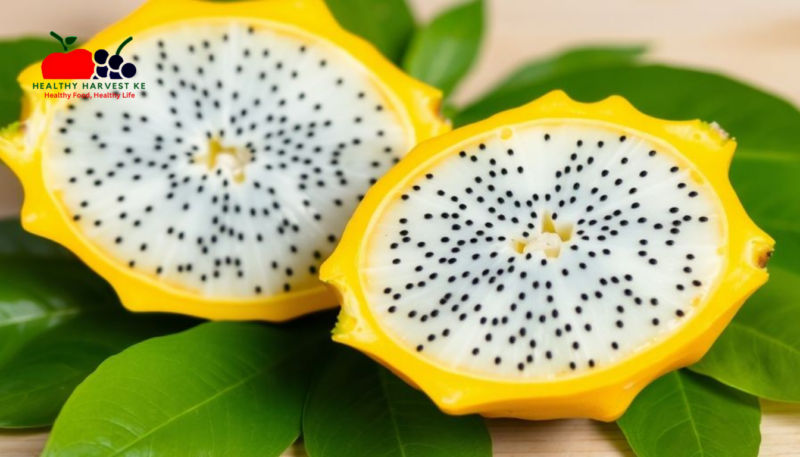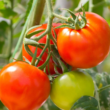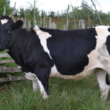The Pink Gold Rush: Why Dragon Fruit Is Kenya’s Most Profitable Crop
If you’re looking for a crop that delivers serious returns without the headache of constant maintenance, dragon fruit farming in Kenya is your answer. This exotic fruit isn’t just catching eyes with its vibrant pink exterior and speckled interior – it’s catching serious cash, selling for anywhere between Ksh 800 to Ksh 1,500 per kilogram. That’s right, we’re talking about Kenya’s most expensive fruit, and the market can’t get enough of it.
The math is simple: high demand + limited supply = golden opportunity for smart farmers ready to make a move. While traditional crops struggle with price fluctuations and market saturation, dragon fruit farming is still in its early stages in Kenya, giving first-movers a serious advantage in this agricultural gold rush.
What Makes Dragon Fruit So Special?
Dragon fruit (pitaya) isn’t just another pretty face in the produce aisle. This tropical fruit from the cactus family brings both beauty and substance to the table. With its bright pink skin, green scales, and juicy interior filled with tiny black seeds, it’s as Instagram-worthy as it is nutritious.
Originally from Central and South America, dragon fruit has found its second home in Kenya’s diverse climate zones. The fruit’s mild, sweet flavor has made it a hit with health-conscious consumers both locally and internationally. More importantly, it’s a crop that doesn’t just survive in Kenya – it thrives, especially in semi-arid regions where conventional crops might struggle.
The Numbers Don’t Lie: Dragon Fruit’s Profit Potential
If you’re wondering whether dragon fruit farming is worth your time and investment, consider this: a well-managed one-acre dragon fruit farm could generate approximately Ksh 10 million annually. Even if market forces eventually drive prices down to Ksh 400 per kilogram as more farmers enter the market, you’re still looking at substantial returns.
Let’s break down the economics:
- Current retail price: Ksh 800-1,500 per kilogram
- Individual fruits can sell for around Ksh 300 each
- Upscale grocery stores like Zucchini sell a single dragon fruit for up to Ksh 890
- Export potential with rates reaching KES 800 per kilogram
The high-value nature of this crop, combined with its multiple harvests per year, creates a business model that’s hard to beat in traditional agriculture.
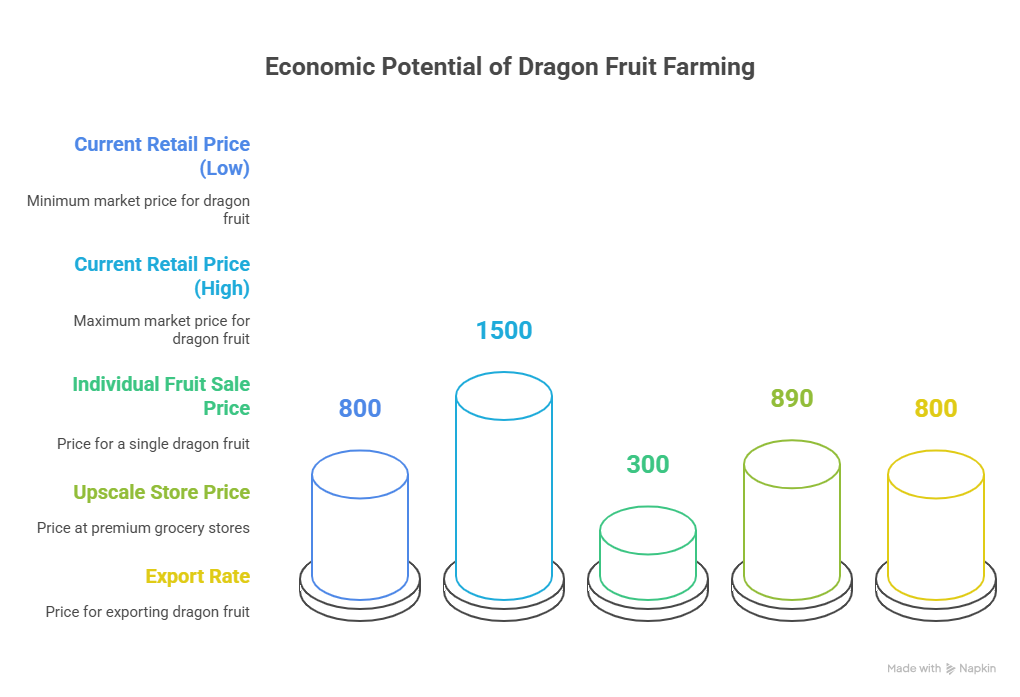
Getting Started: What You Need to Know
Climate and Soil Requirements
Dragon fruit isn’t demanding when it comes to growing conditions – one reason it’s perfect for Kenya’s diverse agricultural zones. The plant thrives in:
- Temperatures between 20°C and 35°C
- Rainfall between 400mm and 1,500mm per year
- Well-drained sandy or loamy soil with pH between 6 and 7.5
If you’re in an area with less than 400mm annual rainfall, don’t sweat it – simple irrigation can help boost fruit size and overall yields. The plant’s cactus heritage means it’s naturally water-efficient, making it suitable for regions prone to dry spells.
Planting and Support Structures
Dragon fruit grows as a semi-epiphytic vine, meaning it needs something to climb on. Here’s what works best:
- Strong vertical support structures (many farmers use precast concrete poles)
- Spacing of 4m x 2.5m to 5m x 2.5m, allowing for high-density planting of up to 1,250 plants per hectare
- Support structures around 1.8 meters high
Since these plants can live productively for 20-30 years, investing in durable support structures from the start is crucial. Think of it as building the foundation for two decades of profit.
From Planting to Profit: The Timeline
One major advantage of dragon fruit farming is its relatively quick return on investment. Unlike crops that take 5+ years to become profitable, dragon fruit starts producing within 18-24 months after planting. Once mature, each plant can produce four harvests annually, with each tree yielding up to 50 fruits per harvest.
This multiple-harvest system creates a steady income stream throughout the year, helping to even out cash flow – a rare luxury in seasonal agriculture.
Maintenance: Less Work, More Fruit
Despite its exotic appearance, dragon fruit won’t have you slaving away in the fields all day. It’s surprisingly low-maintenance compared to traditional crops:
- Requires less water than conventional crops
- Responds well to both soil and foliar fertilizing
- Needs regular but simple pruning to manage growth and improve air circulation
The plant’s natural resilience means fewer pesticides and less intensive care, saving you time and money while keeping your farming practices more environmentally friendly.
Real Success Stories: Kenyan Farmers Who Made It Big
The Computer Scientist Turned Dragon Fruit Millionaire
Priscilla Nyairia isn’t your typical farmer. A Computer Science graduate, she and her husband started a dragon fruit farm along the Nyeri-Nyahururu road with just 100 trees. Their approach was methodical and hands-on – propagating their own cuttings and carefully transplanting them.
Their first harvest in 2021 was a game-changer. Each fruit sold for Ksh 1,000, generating Ksh 1 million in revenue from just 200 plants. After subtracting their setup cost of Ksh 200,000, they walked away with Ksh 800,000 in profit. Today, their farm enjoys four harvests annually, with each tree yielding up to 50 fruits per harvest.
Priscilla’s story shows that you don’t need agricultural credentials to succeed in this business – just smart planning and execution.
From Skeptic to Believer: Jane Mwangi’s Journey
Jane Mwangi from Nakuru was initially skeptical about dragon fruit farming. It seemed too exotic, too different from traditional Kenyan agriculture. But facing challenges with conventional crops, she decided to take a leap of faith with dragon fruit on a small plot of her farm.
The results blew her away – the crop proved both easy to grow and highly profitable. What started as an experiment has transformed her farming business and income stability.
John Ochieng’s Impressive Yields
Farmer John Ochieng reports harvesting up to 15 tons per hectare annually from his dragon fruit farm. He emphasizes that the profitability is unmatched, especially considering the minimal water and maintenance required compared to traditional crops. His success demonstrates the scalability of dragon fruit farming from small plots to larger commercial operations.
Market Dynamics: Who’s Buying and Why
The dragon fruit market in Kenya is experiencing rapid growth, driven by:
- Health-conscious consumers seeking nutritious options
- Asian communities in Kenya who are traditionally familiar with the fruit
- Curious food enthusiasts excited to try exotic produce
- Export markets in Europe and the Middle East paying premium prices
Currently, demand exceeds local production, with a significant portion of dragon fruits consumed by Kenya’s elite population being imported from Vietnam, the world’s largest producer. This gap creates a substantial opportunity for local farmers to capture market share.
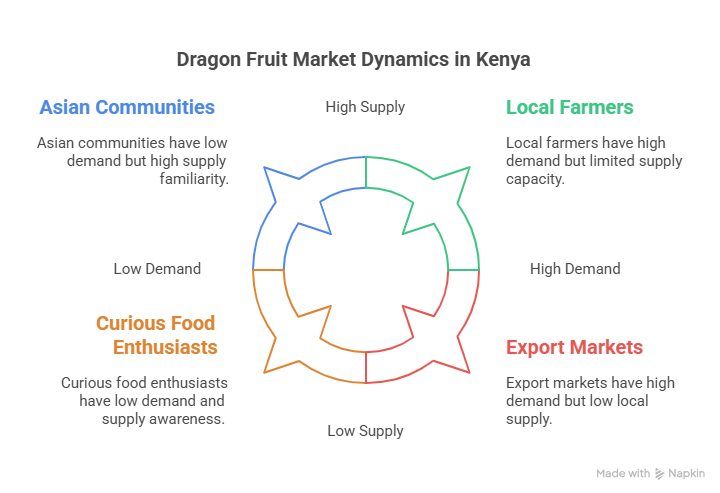
Seasonal Considerations and Planning
Understanding the seasonal patterns of dragon fruit production is crucial for maximizing your returns:
- Peak production seasons in Kenya run from November to May
- January through April are optimal months for fruit development
- Planning your planting and maintenance around these cycles can help you hit the market when prices are highest
This seasonal knowledge helps you schedule everything from planting to harvest to marketing, ensuring you get the best possible prices for your produce.
Challenges You Should Prepare For
No farming venture is without challenges, and dragon fruit is no exception. Being prepared for these hurdles will give you an edge:
- Initial investment in quality planting material can be significant (some farmers import cuttings at $10 each)
- Setting up robust support structures requires careful planning and investment
- As more farmers enter the market, competition will increase, potentially affecting prices
- Marketing and distribution channels may need development, especially for export markets
The good news? These challenges are manageable with proper planning and execution, and the potential returns far outweigh the risks.
Getting Started: Your Action Plan
Ready to dive into dragon fruit farming? Here’s your step-by-step action plan:
- Research and Visit: Connect with successful dragon fruit farmers in Kenya like Priscilla Nyairia or others mentioned in this article. There’s nothing like seeing a thriving operation firsthand.
- Site Selection: Choose land with good drainage, adequate sunlight, and water access. Remember, dragon fruit thrives in temperatures between 20°C and 35°C.
- Source Quality Planting Material: Start with healthy cuttings from reputable sources to ensure good genetics and disease-free plants.
- Prepare Support Structures: Invest in durable support systems that will last for the 20+ year lifespan of your dragon fruit plants.
- Master the Basics: Learn proper planting techniques, pruning methods, and appropriate fertilization practices.
- Plan Your Market Strategy: Identify potential buyers before your first harvest, whether local markets, exporters, or direct-to-consumer channels.
- Start Small, Scale Smart: Begin with a manageable plot to learn the ropes before expanding – many successful farmers started with just 100-200 plants.
Conclusion: The Future of Dragon Fruit Farming in Kenya
Dragon fruit farming represents a golden opportunity for Kenyan agricultural entrepreneurs. With its high market value, growing demand, and suitability for Kenya’s climate, it offers substantial returns on investment with relatively low maintenance requirements.
As one successful farmer put it, “the early bird catches the worm” – suggesting that those who enter this market sooner rather than later stand to gain the most from its current premium pricing. The experiences of farmers like Priscilla Nyairia, Jane Mwangi, and John Ochieng demonstrate that with determination and proper management, dragon fruit farming can indeed be the “new gold mine” for Kenyan farmers.
The question isn’t whether dragon fruit farming is profitable – the evidence clearly shows it is. The real question is: are you ready to claim your share of this pink gold rush?




